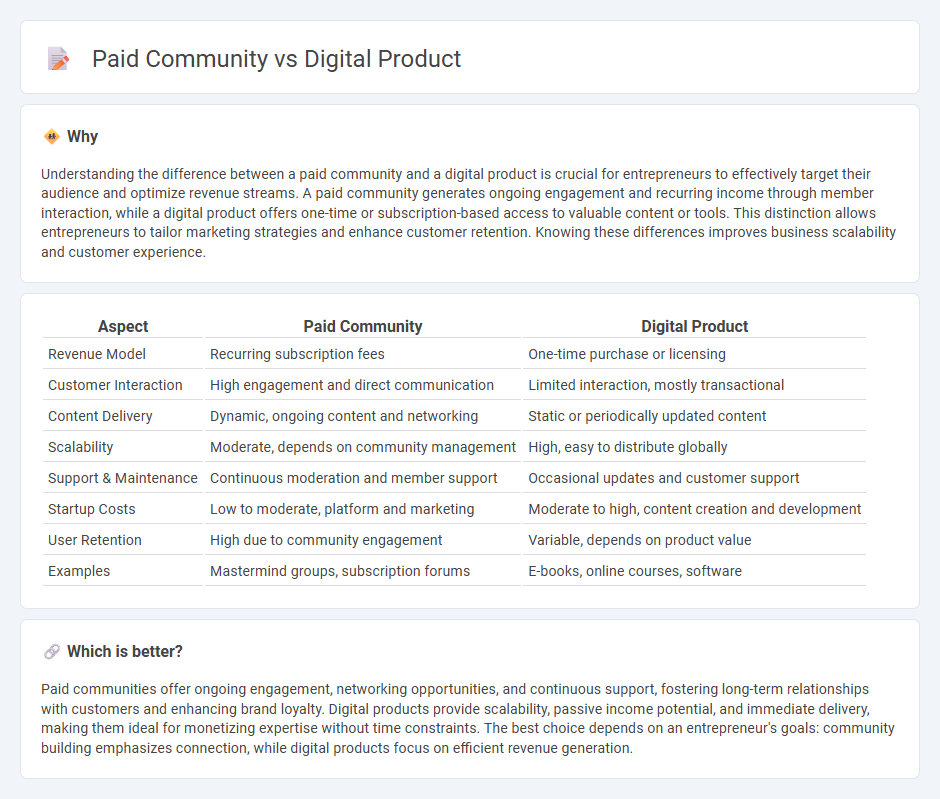
Paid communities offer ongoing engagement and personalized support through exclusive member interactions, fostering strong networking and collaboration opportunities. Digital products provide scalable, one-time value such as eBooks, courses, or software, enabling entrepreneurs to generate passive income. Discover how these models can uniquely enhance your business growth and customer experience.
Why it is important
Understanding the difference between a paid community and a digital product is crucial for entrepreneurs to effectively target their audience and optimize revenue streams. A paid community generates ongoing engagement and recurring income through member interaction, while a digital product offers one-time or subscription-based access to valuable content or tools. This distinction allows entrepreneurs to tailor marketing strategies and enhance customer retention. Knowing these differences improves business scalability and customer experience.
Comparison Table
| Aspect | Paid Community | Digital Product |
|---|---|---|
| Revenue Model | Recurring subscription fees | One-time purchase or licensing |
| Customer Interaction | High engagement and direct communication | Limited interaction, mostly transactional |
| Content Delivery | Dynamic, ongoing content and networking | Static or periodically updated content |
| Scalability | Moderate, depends on community management | High, easy to distribute globally |
| Support & Maintenance | Continuous moderation and member support | Occasional updates and customer support |
| Startup Costs | Low to moderate, platform and marketing | Moderate to high, content creation and development |
| User Retention | High due to community engagement | Variable, depends on product value |
| Examples | Mastermind groups, subscription forums | E-books, online courses, software |
Which is better?
Paid communities offer ongoing engagement, networking opportunities, and continuous support, fostering long-term relationships with customers and enhancing brand loyalty. Digital products provide scalability, passive income potential, and immediate delivery, making them ideal for monetizing expertise without time constraints. The best choice depends on an entrepreneur's goals: community building emphasizes connection, while digital products focus on efficient revenue generation.
Connection
Paid communities foster entrepreneurship by creating exclusive spaces where digital product creators can directly engage with their target audience, gather feedback, and validate ideas. These communities provide entrepreneurs with valuable insights and support networks crucial for refining and marketing digital products effectively. Monetizing access through memberships enhances revenue streams while nurturing loyal customer bases essential for sustainable digital product growth.
Key Terms
Scalability
Digital products offer unmatched scalability by enabling creators to replicate and distribute content globally without significant incremental costs. Paid communities, while fostering engagement and loyalty, often face scaling challenges due to the need for personalized interaction and moderation. Explore strategies to maximize scalability in both models for sustainable growth.
Engagement
Digital products provide scalable value through tools, courses, or software that users can access independently, offering passive revenue streams. Paid communities thrive on active engagement, fostering real-time interaction, support, and networking that build loyalty and enhance user retention. Explore how combining both can maximize engagement and revenue potential.
Monetization
Digital products generate revenue through one-time sales or subscriptions, offering scalable income with minimal ongoing effort after creation. Paid communities rely on recurring membership fees, fostering engagement and customer loyalty while creating a consistent cash flow. Explore strategies to optimize earnings and community growth for maximum monetization impact.
Source and External Links
What is a Digital Product? - Productfolio - A digital product is an intangible product or service that exists in a digital form, including software applications, digital content like e-books and music, online platforms, SaaS, and digital services primarily delivered and consumed via digital technology.
What Are Digital Products? Sell These 11 Products Online (2025) - Digital products include ebooks, music, digital art, software, online courses, and NFTs, which can be created and sold online without inventory, offering flexibility and scalability to sellers.
80+ Profitable Digital Product Ideas to Sell in 2025 - MailerLite - Digital products are non-physical goods sold online such as ebooks, courses, design assets, audio, and templates, favored for their low startup cost, infinite inventory, ease of scaling, and location independence.
 dowidth.com
dowidth.com